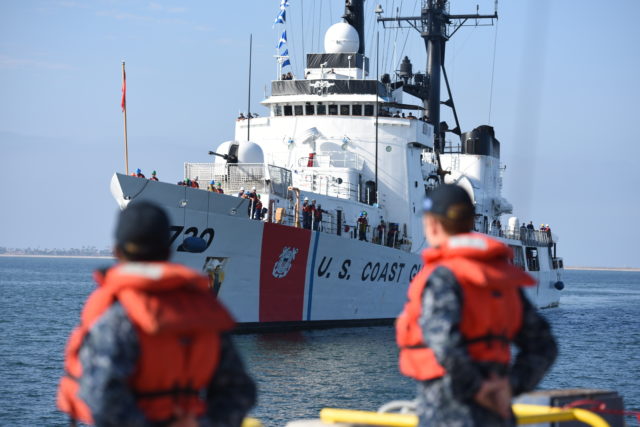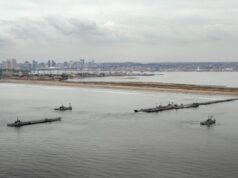
Far offshore in the Eastern Pacific Ocean, it seems as though you are the only trace of human life for hundreds of miles. There is nothing but the vastness of the ocean and the ever-present, often indiscernible line on the horizon where the water meets the sky. Overhead, a Maritime Patrol Aircraft (MPA) flies, searching for vessels in a cat and mouse game that pits law enforcement against illegal smugglers. The solitude is interrupted when the MPA detects a vessel suspected of smuggling, known as a go-fast, operating at a high rate of speed. Go-fasts are often spotted by the white trail, or rooster tail, behind the vessel as its engines churn through the water.
The 40-foot go-fast is headed north, 378 miles west of Acapulco, Mexico with a load of 900 kilograms of cocaine and enough fuel onboard to feed its two thirsty outboard engines as it sprints toward U.S. shores. The MPA relays the position of the go-fast to the Coast Guard Cutter STEADFAST, patrolling 30 miles to the north of the go-fast, and the entire 76 person crew jumps into action as they launch their pursuit boat with a specialized law enforcement team onboard to catch up to – and board – the go-fast. The pursuit boat engages its engines for a high- speed pursuit, reaching the go-fast, which continues to flee, despite the orders of the pursuit boat to stop. Meanwhile, the STEADFAST’s crew coordinates its actions with Coast Guard District 11, which authorizes the use of warning shots and disabling fire, delivered from a specialized weapons package onboard the pursuit boat, to stop the go-fast. The crew aboard the pursuit boat shoots the engines of the go-fast, disabling it and bringing it to a stop. With the go-fast stopped, the boarding team onboard the pursuit boat begins to board the vessel.
Almost immediately upon boarding, someone onboard the go-fast sets fire to a fuel barrel quickly engulfing the vessel in flames, forcing the occupants of the go-fast to jump into the water to escape the ravaging flames. The boarding team unsuccessfully attempts to extinguish the fire and quickly shifts its focus to saving the lives of the six suspects in the water. Although the boarding team is unable to conduct a full investigation and search of the vessel, a portion of the 900 kilogram load of cocaine is recovered before the go-fast burns to the waterline and sinks. All six persons from the go-fast are rescued and later detained onboard the STEADFAST to be brought to the U.S. for prosecution. The Department of Justice prosecutes the case, most notably handing down a harsh sentence to the individual who set the fuel barrel on fire, Jesus Soto-Martinez, who receives a sentence of 21 years and three months on number of charges, including knowingly using fire to commit a felony offense.
A Constant Battle
Stories like this are not uncommon to the Coast Guard’s daily operations. Over the past three years, the Coast Guard has participated in more than 1,100 cases like this one. Despite Trans-national Criminal Organizations’ (TCO) relentless endeavors to traffic harmful drugs through an adaptive set of tactics and exploiting vulnerable pockets of society, American partnerships with South and Central American nations continue to have a stabilizing effect in the region.
Although these partnerships enable and increased level of cooperation, the Coast Guard is only able to disrupt approximately 10% of the known flow of narcotics into the United States. While this may seem like a grim statistic, the outlook is positive; in FY2020, the Coast Guard interdicted nearly 380,000 pounds of cocaine and other dangerous drugs, depriving TCOs of more than $5.3 billion in profits. In FY2019, the 207.9 metric tons of cocaine removed by the Coast Guard is equivalent to 4.16 billion individual doses. That is enough for EVERY American to be drugged for almost 13 consecutive days.
While the Coast Guard continues to achieve success, the playbook for interdiction is ever changing; Drug Trafficking Organizations (DTOs) shift their smuggling tactics to counter the efforts of the U.S. by altering smuggling routes and use of increasingly sophisticated practices to avoid detection through the use of low profile vessels, semi-submersible vessels, and fully submersible vessels to achieve their goals. By attacking the profit source of the cartels in the maritime transit zone, where they are most vulnerable, the U.S. and its partners are able to leverage interdiction as part of a holistic approach to mitigate the cartels’ expansive influence, which is enabled by illicit smuggling.
Partner Nation Efforts
For years, the U.S. Government has trained, equipped, and coordinated with dozens of countries across the Western Hemisphere to help stem the flow of illicit drugs through their waters. As a result of those efforts, partner nations today are contributing to counterdrug operations more than ever. Partner nations in the Western Hemisphere have increased their interdiction capacity in recent years, a capability built through decades of cooperation. The Coast Guard continues to expand capacity building initiatives to assist partner nations in developing their organic maritime governance capabilities, with the added benefit of helping to address challenges and threats to U.S. national security interests.
While the U.S. Government has seen success stories in recent years, a continued “whole of government” approach is imperative, which includes financial support from the Department of State and Coast Guard assistance to build comprehensive maritime governance and logistics systems. Notably, in June, the Coast Guard and Colombian Navy conducted a multi-day boarding of the vessel CAP WHITE, in the Western Caribbean. After extensive efforts by multiple U.S. and Colombian agencies, more than 16,700 pounds of cocaine were seized, the largest Coast Guard cocaine seizure in the Caribbean region in 12 years.
Furthermore, Coast Guard personnel are posted throughout the Western Hemisphere as attachés, liaisons, maritime advisors, and drug interdiction specialists. These personnel develop strategic relationships with partner nations to facilitate the coordination of real-time operations; confirmation of vessel registry; waivers of jurisdiction; and disposition of seized vessels, contraband, and detained crews. The Coast Guard’s law enforcement, legal, and regulatory expertise are in high demand among Central American partners, whose navies more closely resemble the Coast Guard, focused primarily on maritime law enforcement. Coast Guard international training teams, as well as Coast Guard units deployed in the region, increase professional interaction, shiprider activities, and training in conjunction with operations. The invaluable operational knowledge and skill sets conveyed by Coast Guard law enforcement personnel, coupled with the increased capability of partner nations and their assets, enable countries’ maritime enforcement agencies to emerge as powerful force multipliers in the Western Hemisphere.
Working in conjunction with the Departments of State and Justice, the Coast Guard has negotiated, concluded, and maintained 34 counter drug bilateral agreements and operational procedures with partner nations in the Western Hemisphere. These agreements enable the Coast Guard to board suspect vessels, facilitate interdictions in under-patrolled territorial waters of partner nations, deter illicit activity in the littoral regions, and coordinate interdiction and apprehension operations throughout the Western Hemisphere. Nearly 60 percent of all Coast Guard interdictions in fiscal year 2020 involved the use of a bilateral agreement or operational procedures.
Persistent Presence
In order to maintain influence with our partners, the U.S. Government needs to exercise persistent presence including efforts by with and through our foreign partners. American efforts to foster regional collaboration and foreign networks are critical to illuminate illicit behavior where it occurs and to elevate rules-based order throughout the maritime domain. Weaker nations and dictatorial regimes in our hemisphere are being exploited and leveraged against us by our adversaries. Shining a spotlight on these nefarious activities will undermine their efforts and will empower our like-minded partners to stand strong for freedom and democracy.
Recently, the former defense minister of Mexico was arrested in the United States on charges of drug trafficking and money laundering. Additionally, the former head of the Mexican equivalent of the FBI was indicted in the U.S. for receiving bribes in exchange for information and safe passage of drug shipments to the U.S. In the unstable state of Venezuela, Former President Nicholas Maduro was charged with drug trafficking by the Unites States as a part of his suspected leadership of the Cartel de los Soles along with the Chief Justice and Minister of Defense being charged with related offenses. By maintaining constant oversight of our partners, the U.S. aims to reinforce its foothold in the progress it has made internationally. The seemingly unlimited funding of Drug Trafficking Organizations presents a significant threat to those in positions of power who are motivated by money rather than the administration of a just, legal society. Although graft and corruption continue to threaten our successes, it is important to recognize the determination our partners have made toward increasing efforts, capabilities, and contributions to the war on drugs.
The measures taken by partner nations is not without significant risk; while American law enforcement is directly involved in drug interdiction, its members enjoy the relative safety of their homes while not engaged in operations. This is not the same story that those in Latin America experience as the threat of violence against law enforcement and their families persist, even when off duty. In 2009, the family of one of Mexico’s Marines was brutally murdered as retaliation for his role in the death of cartel leader Arturo Beltran Leyva. The cartel message to troops involved in the drug war: “You go after us, we wipe out your families.” The danger of the cartels is not limited to those seeking to dismantle their profit centers. The UN reports a relationship between homicide and known drug trafficking routes. High drug trafficking routes, like those on the coastlines of Honduras and Guatemala and on their shared border, have murder rates more than double of those areas with lower or no known trafficking. The violence, corruption, extortion, and instability that is caused by trafficking drives families from their homes to seek safe havens elsewhere.
On the Front Lines
U.S. Coast Guard members are privileged to take their efforts to the front lines on the war on drugs while making a measurable impact on illicit traffic. This does not preclude our members from experiencing an increase in risk while conducting operations. The Coast Guard has seen a rise in aggressive tactics taken by smugglers who carry weapons or attempt to use their vessel as a weapon in an effort to evade capture. In early August, the Coast Guard was notified of a vessel travelling at a high rate of speed just off the coast of San Diego. Knowing that time is of the essence, the Coast Guard diverted Coast Guard Cutter FORREST REDNOUR from a nearby operating area and notified Customs and Border Protection (CBP) who also diverted an intercept boat to assist.
FORREST REDNOUR immediately responded, launching its small boat to attempt to stop the suspect vessel. When the vessels converged, the suspect vessel began operating erratically, refusing to heed the orders of U.S. Law Enforcement. Both the FORREST REDNOUR’s small boat and CBP’s intercept boat were rammed by the suspect vessel as it attempted to evade capture, causing damage to both vessels and putting the life and safety of those involved at risk. Fortunately, the CBP intercept boat was able to use its onboard force package to disable the engines of the suspect vessel, ending the chase. Law enforcement personnel took the vessel and its occupants into custody along with their illicit cargo of nearly 240 kilograms of methamphetamine, resulting in the largest Coast Guard interdiction of methamphetamine in four years.
Conclusion
The continued efforts of Drug Trafficking Organizations to traffic their illicit products into the United States, coupled with the collateral damage incurred by those involved, underscores the importance of this mission. The Coast Guard along with its government and international partners must perpetually adapt to a dynamic environment while maintaining unity of effort. The issue at the forefront of this fight is undeniable, the lives of millions are at stake.
Capt. Timothy Brown is the Chief of Maritime Law Enforcement. He, Cdr. Don Terkanian and Lt. Pete Harrington are assigned to the Coast Guard’s Response Directorate in Washington D.C.





